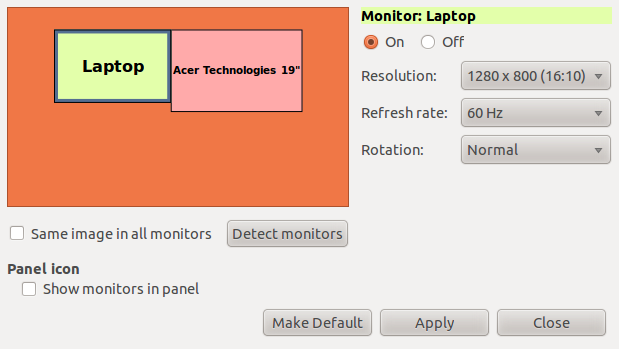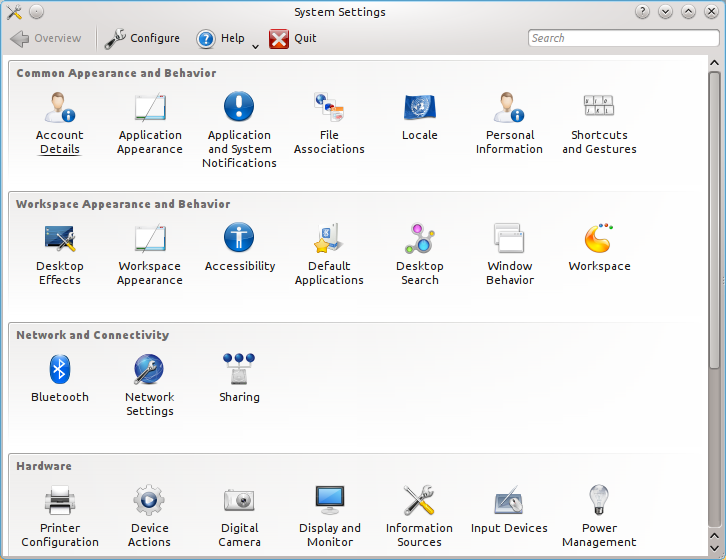6.3 KiB
Dual Monitor Setup
The first step in getting OpenLP working on your system is to setup your computer properly for dual monitors. This is not very difficult, but the steps will vary depending on operating system.
Most modern computers have the ability for dual monitors. To be certain, check your computer's documentation. A typical desktop computer capable of dual monitors will have two of, or a combination of the two, connectors below.
VGA
DVI
A laptop computer setup only varies slightly. Generally you will need
only one of the outputs pictured above since your laptop screen serves
as one of the monitors. Sometimes with older laptops a key stroke
generally involving the Fn key and another key is required to enable the
second monitor on laptops.
Some computers also incorporate the use of S-Video (Separate Video) or
HDMI (High-Definition Multimedia Interface)
connections.
A typical OpenLP setup consist of your normal single monitor, with your projector hooked up to your computer as the second monitor. With the option of extending your desktop across the second monitor, or your operating system's equivalent.
Microsoft Windows
Dual monitor setup is similar among all the currently supported Windows releases (XP, Vista, Windows 7), but does vary slightly from one release to the next.
Windows 7
Windows 7 has using a projector in mind. Simply connect your
projector and press Windows+P.
The more traditional way is also fairly straight forward. Go to Control Panel and click
on Display. This
will open up the Display dialog. You may also bypass this step by
a right click on a blank area on your desktop and selecting Resolution.
Then click on the Adjust resolution link in the left pane. Enable
your projector and make sure that the selected value for Multiple
displays is Extend these displays.
Windows Vista
From Control Panel click on Personalize, or right
click a blank place on the desktop and click Personalization.
From the Personalization window click on Display
Settings. Click on the monitor that represents your projector and
make sure you have checked Extend the desktop onto this monitor.
Windows XP
From Control Panel select Display, or right click
on a blank area of the desktop and select Properties. From the Display Properties
window click on the Settings tab. Click on the monitor that
represents your projector and make sure you have checked Extend my Windows desktop onto this monitor.
Linux
Due to the vast varieties of hardware, distributions, desktops, and drivers this is not an exhaustive guide to dual monitor setup on Linux. This guide assumes you have properly set up any proprietary drivers if needed. You should seek out your distributions documentation if this general guide does not work.
GNOME
This guide is for users of the GNOME desktop who do not use
proprietary drivers. From most distros go to System --> Preferences --> Display
Settings (Monitors). Set up your projector with the correct
resolution and make sure that Same image on all monitors is
unchecked.
KDE
This guide is for users of the KDE desktop who do not use proprietary
drivers. From most distros click the Kick Off menu and navigate to System Settings
Click on the display and monitor icon.
From here you will need to set up your projector with the appropriate resolution, and position. OpenLP works best projecting to the monitor on the right.
Linux Systems Using nVidia Drivers
This guide is for users of the proprietary nVidia driver on Linux
Distributions. It is assumed that you have properly setup your drivers
according to your distribution's documentation, and you have a working
xorg.conf file in place.
If you wish to make the changes permanent in setting up your system
for dual monitors it will be necessary to modify your
xorg.conf file. It is always a good idea to make a backup
of any critical file before making changes:
user@linux:~ $ sudo cp /etc/X11/xorg.conf /etc/X11/xorg.conf.oldOr for those using systems that use the root user instead of sudo, change to root and enter:
root@linux: # cp /etc/X11/xorg.conf /etc/X11/xorg.conf.oldThe exact location of the xorg.conf file can vary so
check your distribution's documentation.
If you want to make your changes permanent run nVidia settings from the terminal:
user@linux:~ $ sudo nvidia-settingsOr, as root:
root@linux: # nividia-settingsIf you do not want to write the changes to your
xorg.conf file simply run the nVidia Settings program
(nvidia-settings)
from your desktop's menu, usually in an administration or system menu,
or from the terminal as a normal user run:
user@linux:~ $ nvidia-settingsOnce you have opened nVidia Settings, click on X Server Display
Configuration. Then select the monitor you are wanting to use as
your second monitor and click Configure.
After clicking Configure, select TwinView. Then click OK.
Click Apply and
if you are happy with the way things look click Keep to keep your new
settings. Don't worry if all goes wrong the settings will return back to
the previous settings in 15 seconds without any action. nVidia Settings
should take care of selecting your optimum resolution etc, but that can
be changed as needed. When you are happy with everything click on Save to X Configuration File.
Click Save and
you should be set. You may want to restart X or your machine just to
make sure all the settings carry over the next time you log in.












